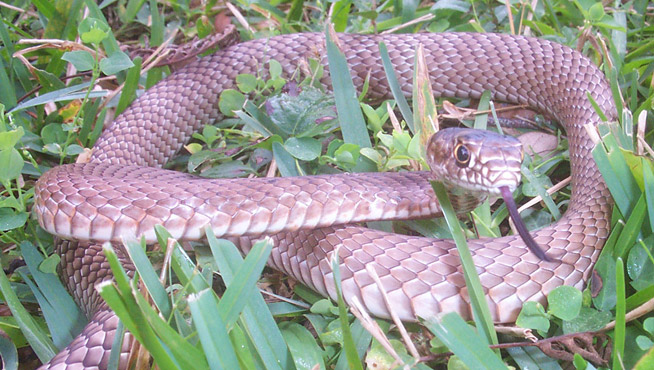
Coachwhip Snake Biology:
The coachwhip snake (Masticophis flagellum) is a species of snake that is native to the southern continental United States, stretching from the east to west coasts. Coach whips are also native to northern Mexico.
Coachwhips are very thin snakes, which is why they are said to resemble a type of whip. Unlike many other snake species the coachwhip has a very thin head that is almost the same width as its body. This can make it difficult to distinguish between the head and the tail of a coachwhip from far away.
While they are extremely thin, coachwhips can reach remarkable lengths. Some adult coachwhips reach nearly two meters in length. A more common length for an adult coach whip is over one meter.
The coachwhip is actually a very diverse species of snake, with several subspecies of coachwhip known to exist. The subspecies include the Sonoran coachwhip, the Eastern coachwhip, the Baja California coachwhip, the Line coachwhip, the Red coachwhip, the San Joaquin coachwhip and the Western coachwhip.
Because of this great diversity the coachwhips in one region often have a different coloration pattern than those in another region. In many areas the most common color for a coachwhip is a shade of brown, but green and even pink or red coachwhip specimens have been collected. The coachwhip can have a unique color pattern that changes from the head of the snake to the tail. This is very unusual in most snake species.
Coachwhips have very distinctive round eyes that are a deep black with a ring of lighter coloration around the pupil. Their large round pupils give the coachwhip snake extremely keen eyesight.
Habitat:
Coachwhips can be found throughout the southern United States and northern Mexico. They are an extremely common sighting in gardens and yards across states like California, Texas, New Mexico, Louisiana, and Florida.
The coach whip usually prefers to live in an open grassy area, such as the southern great plains. However, coachwhip sightings within less dense forest regions are quite common as well.
Behaviour:
Unlike many other colubrid snake species, the coachwhip is diurnal rather than nocturnal. This means that it is most active during the daytime hours between sunrise and sunset. The coachwhip snake’s preference for daytime activities partially accounts for why it is such a common snake to encounter.
Another reason coachwhips are easy to find is that they do not hide much. As active hunters, they are constantly slithering through open grassy areas where a human might encounter them.
Although coachwhips are extremely easy to spot because of their active nature during the daytime, catching one is another matter entirely. Coach whips are known to be exceptionally fast snakes. Furthermore, they are cautious and do not like to be in close proximity to humans. This is why most coachwhip sightings occur when a human surprises one and sees the snake rapidly slithering away.
Coachwhips have an undeserved reputation of aggression towards humans because of their extremely fast speed on land. In reality, coachwhips do not pose any danger to humans. They are usually nonaggressive towards people and do not produce any venom. A coachwhip bite can cause a bit of pain, but as long as the wound is kept clean the person usually recovers from a coachwhip bite with no serious long-term problems.
Diet:
The coachwhip’s keen eyesight makes it an excellent hunter. The coach whip snake does not passively hunt its prey like many other snakes. Rather it will actively go after a potential meal. Coachwhips do not rely on either venom or constriction to capture prey. Instead the coachwhip relies on its speed to quickly grab prey with its mouth.
Its diet consists of any small animal it can catch. Because of its geographic locations, the most common prey of the coachwhip snake are other small reptiles including lizards, frogs and snakes, as well as smaller rodents and birds. Occasionally the coachwhip will eat a large insect or spider as well.
Reproductive:
Like most snake species in the United States, coachwhips typically breed during the spring months from March through June. Coachwhips are oviparous, meaning the female lays eggs rather than giving birth to live young that hatched within the mother. Coachwhip eggs take a few months to hatch. The females are unusual in the great number of eggs they can hatch, with some clutches reaching nearly 30 eggs.
Below are some other species of snake that may look like a Coachwhip Snake:
Copperhead Snake
Diamondback Rattlesnake
Pine Woods Snake
Red Rat Snake
Yellow Rat Snake
Many people want to know how to kill a Coachwhip, but you don't need to. The
best way to get rid of Coachwhips is to simply leave them alone. You can also
use a Coachwhip trap to catch them - that's one of the best ways for how to
remove Coachwhip. For more information, go to my
Snake Removal - How to Get Rid of Snakes home page.